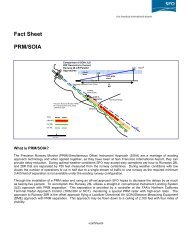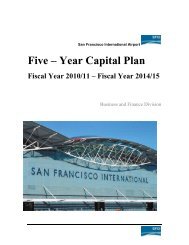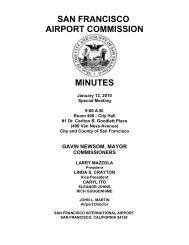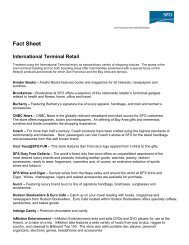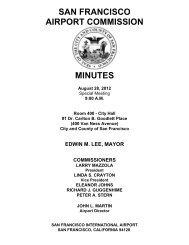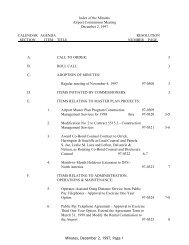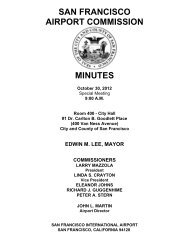Official Statement Airport Commission City and County of San ...
Official Statement Airport Commission City and County of San ...
Official Statement Airport Commission City and County of San ...
You also want an ePaper? Increase the reach of your titles
YUMPU automatically turns print PDFs into web optimized ePapers that Google loves.
Current <strong>Airport</strong> Facilities<br />
General<br />
The <strong>Airport</strong> occupies approximately 5,171 acres, <strong>of</strong> which approximately 2,383 acres have been developed<br />
for <strong>Airport</strong> use. Approximately 2,788 acres are tidel<strong>and</strong>s, <strong>and</strong> have not been developed.<br />
Airfield<br />
General. The runway <strong>and</strong> taxiway system occupies approximately 1,700 acres <strong>and</strong> includes four<br />
intersecting runways, three <strong>of</strong> which are equipped with instrument l<strong>and</strong>ing systems (an “ILS”) for arrivals. Each <strong>of</strong><br />
the four runways is 200 feet wide <strong>and</strong> is paved with asphaltic concrete. The east-west runways are 11,870 <strong>and</strong><br />
10,600 feet long, respectively. The north-south runways are 8,648 <strong>and</strong> 7,500 feet long, respectively. The current<br />
runway system can accommodate the arrival <strong>and</strong> departure at maximum loads <strong>of</strong> all commercial aircraft currently in<br />
service <strong>and</strong> those in development, including the new large aircraft such as the Airbus A-380 <strong>and</strong> the Boeing 787<br />
Dreamliner. The current runways at the <strong>Airport</strong> are built on bay tidel<strong>and</strong>s that were filled during <strong>and</strong> after World<br />
War II. As a result, the runways continue to settle at various rates, <strong>and</strong> require periodic repair <strong>and</strong> maintenance<br />
work.<br />
On-Time Performance. On-time flights are defined by the U.S. DOT as any flight that arrives or departs<br />
within 15 minutes <strong>of</strong> the scheduled arrival or departure time. During calendar year 2008, 69.1% <strong>of</strong> the arrivals at the<br />
<strong>Airport</strong> were on time, down from approximately 69.8% for calendar year 2007, according to the U.S. DOT statistics.<br />
The <strong>Airport</strong>, which operates four runways, was behind the other Bay Area airports in on-time arrivals in calendar<br />
year 2008, with 80.3% <strong>of</strong> on-time arrivals at Oakl<strong>and</strong>, which operates one runway, <strong>and</strong> 80.4% <strong>of</strong> on-time arrivals at<br />
<strong>San</strong> Jose, which operates two runways. Arrival on-time performance is lower at the <strong>Airport</strong> than that <strong>of</strong> the two<br />
other Bay Area airports due primarily to the prevalence <strong>of</strong> low clouds <strong>and</strong> fog around the <strong>Airport</strong> during various<br />
times <strong>of</strong> the year. During calendar year 2008, 75.2% <strong>of</strong> the <strong>Airport</strong>’s departures were on time, down from 75.7% for<br />
calendar year 2007, according to the U.S. DOT On-Time Departure Performance Statistics. This compares to 81.2%<br />
<strong>of</strong> on-time departures for Oakl<strong>and</strong> <strong>and</strong> 84.2% <strong>of</strong> on-time departures for <strong>San</strong> Jose.<br />
The <strong>Commission</strong> has acquired <strong>and</strong> installed an FAA Precision Runway Monitoring System (a “PRM”) for<br />
its primary arrival runways (28R <strong>and</strong> 28L). In good weather conditions (cloud ceiling <strong>of</strong> at least 3,600 feet) 60<br />
planes per hour l<strong>and</strong> at the <strong>Airport</strong>. In adverse weather conditions (cloud ceiling <strong>of</strong> between 1,600 feet <strong>and</strong><br />
3,600 feet) 30 planes per hour were previously permitted to l<strong>and</strong> at the <strong>Airport</strong>. The PRM, combined with the<br />
implementation <strong>of</strong> a Simultaneous Offset Instrument Approach flight procedure, now allows as many as 38 planes<br />
per hour to l<strong>and</strong> during adverse weather conditions.<br />
Improvements to Accommodate New Large Aircraft. The introduction <strong>of</strong> new large aircraft (“NLAs”) will<br />
significantly affect airport design at most airports in the United States where NLAs are expected to operate.<br />
Generally, existing facilities are designed for aircraft having a maximum wingspan <strong>of</strong> 213 feet. It is anticipated that<br />
the NLAs, with a wingspan <strong>of</strong> 262 feet, could require, among other things, reinforced pavement <strong>and</strong> aprons, <strong>and</strong><br />
more clearance <strong>and</strong> separation on the taxiways, at the gates, <strong>and</strong> for the aircraft parking positions.<br />
The <strong>Airport</strong> currently operates three gates in the International Terminal Complex with sufficient clearance<br />
to accept NLAs, <strong>and</strong> is considering making modifications to three additional gates in the ITC to accept NLAs. In<br />
October 2007, the <strong>Airport</strong> completed taxiway modifications to accommodate the NLAs, <strong>and</strong> was the first airport on<br />
the West Coast to do so. As a result, the runways <strong>and</strong> most <strong>of</strong> the taxiways do not require relocation or realignment<br />
to accommodate NLAs. A foreign air carrier is expected to commence the first regularly scheduled NLA flights to<br />
the <strong>Airport</strong> in April 2010.<br />
Terminals<br />
International Terminal. The International Terminal Complex (the “ITC”) is a 2.5 million square foot<br />
state-<strong>of</strong>-the-art facility located directly above an entry roadway network, <strong>and</strong> houses ticketing, Federal Inspection<br />
Service, baggage facilities, concessions, <strong>and</strong> airline <strong>of</strong>fices. The approximately 1.7 million square foot terminal<br />
connects to the new Boarding Areas A <strong>and</strong> G, which have a combined space <strong>of</strong> approximately 850,000 square feet<br />
<strong>and</strong> 24 gates. The ITC (with total floor area covering almost 44 football fields), completed in 2000, is the largest<br />
common use airport terminal in the United States. The <strong>Airport</strong> owns <strong>and</strong> maintains a common use baggage system<br />
37




